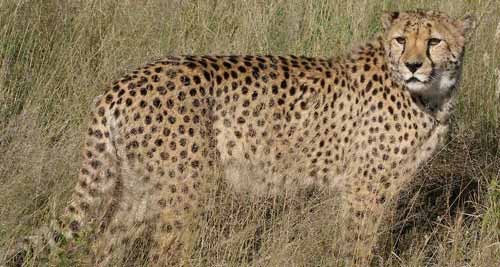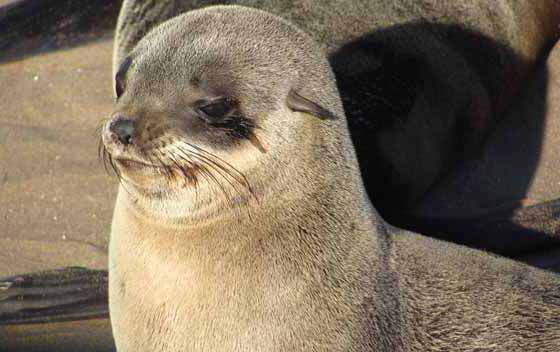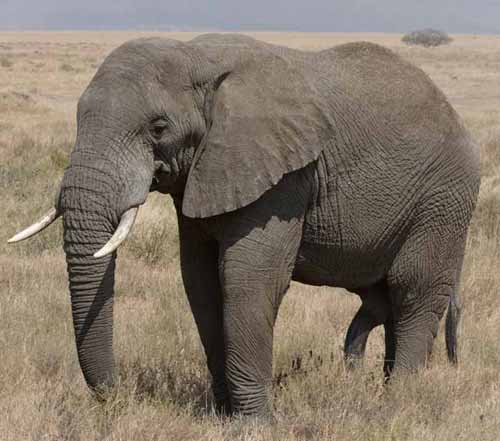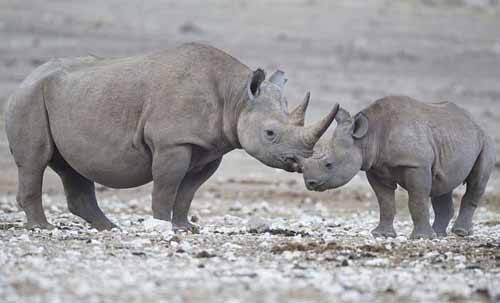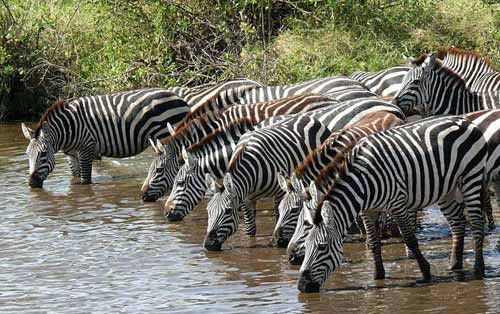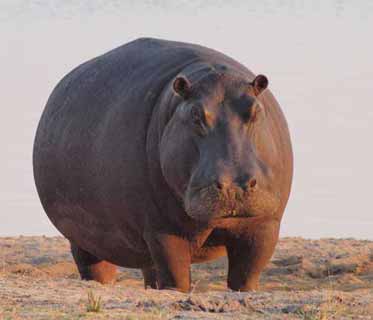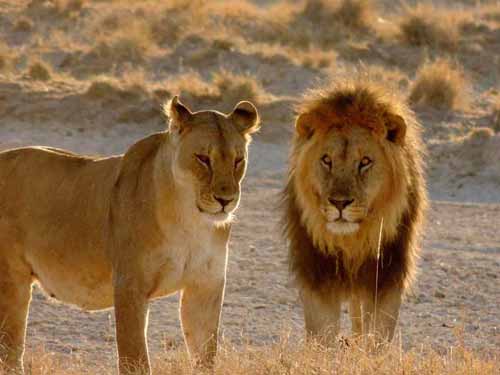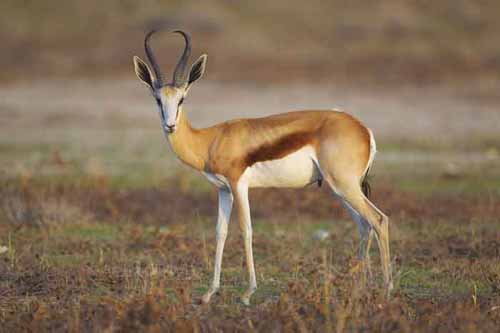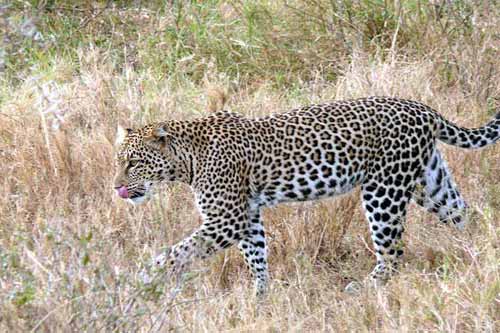Cheetah, Acinonyx jubatus Photo: Africat Foundation. Cheetahs are the fastest land animals. They are unique in other ways, too. They have black spots, rather than stripes, which provide camouflage. The have claws that are more like a dog’s claws than like the claws of other cats. They are very flexible, which helps them run with such great speed. Cheetahs are found in Bwabwata National Park, Nkasa Rupara National Park, Mudumu National Park, Erindi Game Reserve, Naankuse Wildlife Sanctuary, Palmwag Nature Reserve, and occasionally in Etosha and Khaudom National Parks. Cheetahs are an endangered species. In fact, according to CITES, “The troubling reality is that the wild cheetah population is declining. The most recent population estimate is fewer than 10,000 animals, mostly in the savannahs of Eastern and Southern Africa, with a very small Asiatic population in the Islamic Republic of Iran.” Despite this, Namibia allows the killing of cheetahs, both by trophy hunters and farmers. If you decide to travel to Namibia, you may want to look up the Cheetah Conservation Fund. Consider postponing your trip until Namibia protects its wildlife assets. Be sure to send a note to the Minister of Environment and Tourism.
Cape fur seal Arctocephalus pusillus Photo: Earthrace. Cape fur seals, also known as brown fur seals, are eared seals, in the same family, Otariidae, as sea lions. Unlike true seals, Cape fur seals are adept on land. They breed on rocky outcroppings and beaches. Pups and mothers communicate with unique vocalizations that allow them to reunite after the mothers go to sea to feed. Pups are usually weaned at about 10 to 12 months of age. Cape fur seals are a threatened species and have suffered multiple mass die-offs since 2000, mostly due to lack of prey. Despite such threats, the government of Namibia allows clubbers to beat and stab up to 80,000 seal pups to death each year in their beach rookeries (“Seal Reserves”) at Cape Cross, Atlas Bay, and Wolf Bay. Clubbers separate a group of pups from their mothers early each morning from July to mid-November; and, after killing the pups, they bulldoze over the bloody sand before tourists are allowed to enter the reserves. At various times, the Minister of Fisheries and Marine Resources, Bernard Esau, has described this as a jobs program or as a means to reduce fish consumption by seals. To read more about the Cape fur seal slaughter, visit Seal Protection Namibia. Consider postponing your trip until Namibia protects its wildlife assets. Be sure to send a note to the Minister of Environment and Tourism.
Giraffe Giraffa camelopardalis. Photo: Jurvetson (flickr) Giraffes are the tallest land animal. Their legs alone can be 1.8 m long. This gives them the ability to run up to 56 kph. Their long necks are not only used for foraging; males battle each other by “necking,” in which they lean against each other to see which combatant can remain more erect or they swing their necks at each other. In most cases, there are no serious injuries from these battles. Giraffes are herbivorous, eating mostly acacia leaves. They travel in groups without strong social bonds. Mothers raise their young, generally without assistance from males. However, mothers and their young often form nursery herds in which one mother can look after a number of calves while other mothers forage away from the herd. There are as many as 9 subspecies, which do not interbreed. Two are endangered. Namibia has the subspecies angolensis. They are found in Khaudom National Park, Ehirovipuka Conservancy, Kaokoland Nature Reserve, Kaudom Game Reserve, Naankuse Wildlife Sanctuary, and Palmwag Nature Reserve. The Namibian government allows trophy hunting of giraffes. Consider postponing your trip until Namibia protects its wildlife assets. Be sure to send a note to the Minister of Environment and Tourism.
African (bush) elephant Loxodonta africana Photo: Ikiwaner The African bush elephant is the largest land animal. They are herbivorous, eating a variety of leaves and herbs depending on the flora available in their environment. Elephants use their trunks not only for picking up objects, including food, but also for communicating. Elephants form herds made up of an elder female and her relatives. Adolescent males form bachelor herds until they reach adulthood, when they become solitary, except during mating seasons. Elephants are found in Bwabwata National Park, Etosha National Park, Khaudum National Park, Nkasa Rupara National Park, Mudumu National Park, Skeleton Coast National Park, Caprivi Game Park, Ehirovipuka Conservancy, Kaokoland Nature Reserve, Kaudom Game Reserve, and Palmwag Nature Reserve. Elephants are being killed at such an alarming rate in Africa that they are expected to go extinct within a few decades. Most are killed by poachers who are often well-armed and sell the ivory tusks to Asians to fund terrorist activities. Despite this, the government of Namibia still allows elephants to be killed by trophy hunters and has also lost elephants to poachers. In addition to the threat to elephant populations, killings profoundly affect elephants and their social structures. Research shows that elephants have excellent memories and lead rich emotional lives, including mourning their dead. Consider postponing your trip until Namibia protects its wildlife assets. Be sure to send a note to the Minister of Environment and Tourism.
Rhinoceros, Ceratotherium simum (white rhinoceros), Diceros bicornis (black rhinoceros). Photo: Yathin S. Krishnappa, black rhino. The black rhinoceros is actually not black, but gray or brown. Its other name is hook-lipped rhinoceros, which distinguishes it from the white rhinoceros, which is also grey and is also known as the square-lipped rhinoceros due to its wide jaw. The black rhino is endemic to eastern and southern Africa. The southern white rhino is native to southern Africa, and the northern white rhino is native to several east and central African countries. White rhinos often live in herds; whereas black rhinos are more solitary. White rhinoceros are more territorial than black rhinos.Rhinos are found in Erindi Private Game Reserve, Kaokoland Nature Reserve, Palmwag Nature Reserve, and Waterberg National Park. The rhino is critically endangered, and several subspecies have already been driven to extinction by hunters and poachers. Poaching and trophy hunting continue to threaten rhinos today in Namibia. Consider postponing your trip until Namibia protects its wildlife assets. Be sure to send a note to the Minister of Environment and Tourism.
Zebra Equus quagga, Equus zebra. Photo: Haplochromis Zebras are related to horses and donkeys. There are two types of zebras in Namibia: plains zebras and mountain zebras. The latter are threatened with extinction due to hunting and habitat destruction by humans. These two types of zebras live in harems, with one stallion, up to six mares, and the foals. Zebras are herbivorous, eating mostly grasses but also some shrubs, leaves, and twigs. Zebras are found in Etosha National Park, Skeleton Coast National Park, Daan Viljoen Game Reserve, Ehirovipuka Conservancy, Naankuse Wildlife Sanctuary, Naukluft Mountain Zebra Park, and Palmwag Nature Reserve. The Namibian government allows trophy hunting of zebras. Consider postponing your trip until Namibia protects its wildlife assets. Be sure to send a note to the Minister of Environment and Tourism.
Hippopotamus Hippopotamus amphibius Photo: Gusjer. The hippopotamus is the third largest land mammal and is most closely related to cetaceans though their appearance is more like pigs. They can weigh over 2000 kg. Hippos can run 30 kph for short distances. They have webbed feet and nostrils high on their snouts, enabling them to spend much of the day submerged in water. In the evenings, they leave the water to graze on grasses. Hippos are not territorial on land but do stake out territories in rivers, usually with one dominant male and 10 or more females. Young submissive males also stay in these herds. Hippos can be found in Bwabwata National Park, Nkasa Rupara National Park, and Popa Game Park. Hippos are considered a vulnerable species (likely to become endangered) due to hunting/poaching and loss of access to water. Namibia allows trophy hunting of hippos. Consider postponing your trip until Namibia protects its wildlife assets. Be sure to send a note to the Minister of Environment and Tourism.
Lion Panthera leo Photo: robur.q. The lion is the second-largest cat. Lions are found in Africa and India. They usually live in savannas in prides with females and their offspring, as well as some adult males. Male lions typically weigh under 200 kg and have large manes, which can vary in color; however, some males have thin manes or none at all. Males with darker and denser manes are favored by females. Lions are mostly nocturnal and spend about 20 hours resting or sleeping each day. They are found in Bwabwata National Park, Skeleton Coast National Park, Ehirovipuka Conservancy, Erindi Game Reserve, and Kaokoland Nature Reserve. Namibia allows trophy hunting of lions. Consider postponing your trip until Namibia protects its wildlife assets. Be sure to send a note to the Minister of Environment and Tourism.
Springbok antelope Antidorcas marsupialis Photo: Yathin S. Krishnappa. Antelopes are found throughout Namibia. They are members of the Bovidae family and include the greater kudu Tragelaphus strepsiceros, roan antelope Hippotragus equinus, eland Taurotragus oryx, common reedbuck Redunca arundinum, gemsbok Oryx gazella, springbok Antidorcas marsupialis, puku Kobus vardonii, and blue wildebeest Connochaetes taurinus. The roan antelope is found only in northeastern Namibia, in Bwabwata National Park, Caprivi Game Park, and Kaudom Game Reserve. The puku is found only in Nkasa Rupara National Park and has been listed as a “near threatened” species by the International Union for Conservation of Nature (IUCN). Antelopes are herbivorous, grazing mostly on grasses. Most are diurnal, but the reedbuck is one exception. Most form herds. In some cases, females form small groups with their offspring, whereas males form groups of bachelors. Others form harems with a dominant male and several females. Namibia permits the killing of antelopes by trophy hunters. Consider postponing your trip until Namibia protects its wildlife assets. Be sure to send a note to the Minister of Environment and Tourism.
Leopard Panthera pardus Photo: Haplochromis Leopards are found througout Namibia. They are similar to jaguars. Jaguars live in a variety of habitats, including rainforests and arid grasslands. They have large skulls with powerful jaws that allow them to drag their prey behind trees for cover. They are able to climb trees and even drag their prey into trees. Most are nocturnal. They prey on a wide variety of animals, including insects, fish, rodents, antelopes, and monkeys. They have been hunted to extinction in parts of their historic range. In Namibia, they are found in several parks, including Bwabwata National Park, Ehirovipuka Conservancy, Erindi Game Reserve, Naankuse Wildlife Sanctuary, NamibRand Nature Reserve, and Palmwag Nature Reserve. The Tsaobis Leopard Park was a private park that was nationalised and converted to Tsaobis Nature Park. The leopard and cheetahs were taken to Amani Lodge, a refuge 20 km southwest of Windhoek. Namibia permits the killing of leopards by trophy hunters. Consider postponing your trip until Namibia protects its wildlife assets. Be sure to send a note to the Minister of Environment and Tourism.
Share your Namibian wildlife photos

|
Upload files
|
|
|
|
|
|
|

